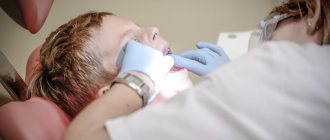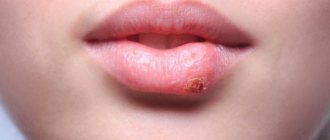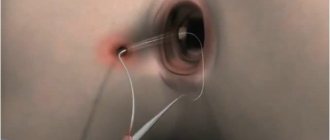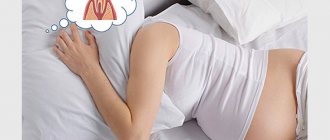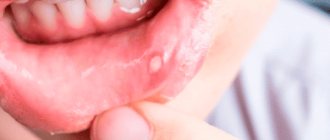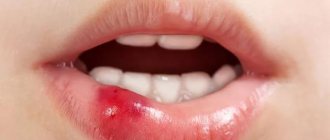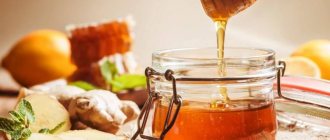Reasons for appearance
Our skin is one of the most delicate. The top layer of the skin is constantly exposed to negative factors: frequent changes in temperature conditions, various mechanical damage and other influences that can damage the epidermis. The appearance of ulcers is evidence that some malfunctions have appeared in the human body. Through these changes, the rate of regeneration of the upper layer of the skin slows down.
The appearance of ulcers on the face can lead to many problems for a person.
Conventionally, all types of oral ulcers can be combined into 2 broad groups:
- ulcers, the formation of which is associated with damage to the tissues of the oral mucosa;
- ulcers as symptoms of another disease.
It is important to correctly determine the cause of the formation of such a defect and begin treatment in order to exclude complications and the occurrence of a serious illness.
First, let's look at the causes of ulcers due to damage to the mucous membrane and tissues of the oral cavity. These include:
- Stomatitis – sores of an infectious nature;
- Injuries – ulcers of traumatic origin.
The main factors in the development of weeping sores and the pathological condition of the skin are considered to be bacterial damage. But also the main reasons for the formation of weeping sores in women and men include:
- Intoxication of the skin. People whose professional activities are related to the chemical industry come into daily contact with chemical liquids and poisons and suffer from the fact that the protective layer of the skin is destroyed over time. This chemical effect causes weeping dermatitis, which, when neglected, transforms into trophic ulcers of varying depths. The risk group for skin intoxication includes people living in areas with poor ecology.
- Digestive pathologies. At the stage of food processing in the body, many organs and systems are involved. If the intestines, liver, and gall bladder are not able to cope with their functions normally, skin problems arise. Local irritations with signs of weeping form.
- Infectious infection. Weeping often occurs under the influence of active pathogenic microflora on the skin. This could be streptococci that enter the wound and begin rapid reproduction, which injures the epithelium. Thus, a red and constantly weeping area gradually becomes an ulcer with a chronic process of bacterial population.
- Complicated allergies. Patients prone to developing hypersensitivity often suffer from skin problems. With constant or frequent inflammation of the skin under the influence of allergens, some areas change their structure and weeping occurs.
- Fungi. Penetration of fungi into the skin is a common cause. Infection easily occurs in public places - visiting a bathhouse, sauna, swimming pool. A distinctive characteristic of fungal development is intense redness and an unpleasant yeasty odor. Those areas where air flows poorly - folds and places with insufficient ventilation - begin to get wet. Fungal weeping is called dermatomycosis.
- Hormone imbalance. An excess or deficiency in the body of certain hormones involved in metabolic processes in skin cells provokes weeping dermatitis with a large number of foci of inflammation. Most often, this disorder develops in people with endocrine diseases.
- Taking medications. Some medications produce side effects of skin atrophy in the area of their effect. Such disorders are often provoked by the use of corticosteroid ointments. First, a persistent weeping forms, and subsequently the epithelial layer becomes so thin that ulcers appear.
Inflammation
Weeping is the process of separation of serous contents through microscopic trauma to the epidermis. It often manifests itself with inflammation with blisters, similar to eczema, but differs in the following symptoms:
- swelling of damaged areas;
- the formation of more red spots and bubbles;
- the blisters are filled with pus;
- At the site of inflammation, cracks of varying depths form.
Vesicles
The first signs of weeping are the formation of small red bubbles on the skin - in a group or one at a time. A vesicle is a hemispherical bubble rash, the size from a pinhead to an average pea. A serous fluid accumulates inside - clear or slightly cloudy, sometimes with blood. Blisters periodically burst, erosion forms in their place, it dries out and becomes crusty.
Vesicles are most often localized on the face, arms and legs, but can also be in other places. Their appearance is accompanied by itching and burning, and outwardly they look like a cosmetic defect. Treatment of weeping wounds involves identifying the causes.
Weeping dermatitis is a skin pathology that develops under the influence of negative external factors or problems in the functioning of organs. Most often, weeping occurs when a streptococcal infection penetrates the dermis.
The main difference between weeping dermatitis is that the skin is in a state of persistent inflammation, it is moist, and over time ulcers with pus form on it. In children, when streptococcus and the waste products of this bacterium enter the thickness of the skin, streptoderma develops. In this case, weeping sores form on the child’s body, which must be treated as prescribed by a doctor and not taken independent measures.
Weeping also causes visculopustulosis in children and newborns. The causes and treatment of pathology are inextricably linked. The disease is an inflammation of the eccrine sweat glands and occurs due to the lack of treatment for heat rash, which is common in infants. The disease is caused by staphylococci. It should be noted that this pathology is severe and the condition is often corrected in a hospital. The main methods of treating vesiculopustulosis are:
- refusal to swim so that the infection does not spread to healthy skin;
- unaffected skin is additionally treated with Furacilin solution and other antiseptics;
- rashes are cauterized with blue or brilliant green and lubricated with antibacterial ointments;
- in case of spread, antibacterial treatment with penicillins and immunostimulants is carried out for 7 to 10 days.
We suggest you read: After tooth extraction, your cheek is swollen, what to do, what to rinse.
Poorly healing wounds are often accompanied by weeping due to the penetration of bacteria into them and the manifestation of additional infectious inflammation. In order for rapid healing of weeping wounds on the skin to occur, it is necessary to accurately determine their causes and try to eliminate the impact. Otherwise, only a strong ointment will help, but it only relieves the symptoms for a while, which then develop with renewed vigor.
Weeping and vesicles indicate an exacerbation, when the skin can additionally easily become infected with staphylococci or streptococci. Most doctors say that if weeping develops, you will need to give up fatty ointments, which only worsen the condition of the injured area. Emulsions and creams are more suitable; they will not interfere with the evaporation of moisture.
With pronounced exudation, drying and astringent agents with zinc, lotions, wet-drying compresses with medicinal solutions, hormonal and non-steroidal ointments are needed.
Causes of poor wound healing
Wound - mechanical damage to the skin, mucous membranes or deep soft tissues. In medicine, this type of injury is distinguished by the mechanism of occurrence, method of application, depth and other parameters.
The process of tissue regeneration (restoration) occurs in several stages: the phase of inflammation, proliferation (cell growth) and healing. Each stage can be influenced by different factors. Some promote healing, while others slow down the process.
The reason for poor tissue healing may be hidden in the following:
1. Infection. After an injury, it is important to properly treat the damaged areas of the skin, otherwise there is a high risk of infection. Pathogenic microorganisms contribute to the development of an inflammatory process, often of a purulent nature. In this case, weeping wounds appear on the skin, there is a local increase in temperature, swelling, pain and redness.
2. Diabetes mellitus. With this disease, blood circulation in the tissues is disrupted, cell nutrition deteriorates, as a result of which the regeneration process slows down. In people suffering from diabetes, even a small scratch can turn into a large wound that will heal poorly, constantly fester, increase in size, and affect deeper soft tissues, causing their necrosis (death). In diabetes mellitus, wounds often appear on the legs in the area of the feet or lower legs. If treatment is absent or carried out incorrectly, gangrene can even develop with the threat of sepsis.
3. Old age. In people over 50 years of age, the process of tissue regeneration and epithelization occurs slowly, this is due to low collagen production and reduced activity of immune cells. The cause is also chronic diseases, as well as the lack of proper treatment or first aid after an injury.
4. Deficiency of vitamins and minerals. If there is a lack of vitamins A, E, C or group B in the human body, the process of skin regeneration slows down. In addition, the condition of hair, nails, skin, and teeth worsens.
5. Poor circulation. The cause is often trophic ulcers, varicose veins, obesity, tumors, and exhaustion of the body. In such conditions, metabolic processes in the affected areas are disrupted, and the skin becomes sensitive to any injuries and infections.
6. In addition to the main reasons, the speed of skin healing is influenced by the state of the immune system (for example, its suppression in HIV leads to the rapid spread of infection and poor tissue healing), the use of certain medications, the quality of nutrition and lifestyle.
With deep, lacerated wounds with a large distance between the edges, necrosis, the healing process will be delayed even in a completely healthy person, and a scar will certainly remain at the site of damage.
What diseases cause ulcers on the patient’s skin?
The fact that there are any disturbances in the functioning of the human body may be indicated by ulcerative formations on the skin. If the skin condition changes, the patient may develop the following diseases:
- The appearance of tumors.
- Varicose veins, thrombophlebitis, thrombosis, vascular spasms, arteriovenous fistulas, embolism.
- Lymphatic drainage may occur with anemia and diabetes.
- Progressive paralysis.
- Changes in vascular walls.
All diseases can lead to the appearance of additional infections, as well as bleeding if the diagnosis and treatment are poor and untimely.
Every fifth person is susceptible to the appearance of various wounds inside the oral cavity. It is impossible to say unequivocally about the causes of ulcers on the cheeks in the mouth: it can form as a result of injury to the mucous membrane or be a symptom of internal pathology. If you quickly begin treating an ulcer caused by mechanical damage, no complications will arise.
So, various pathologies can cause an ulcer in the mouth on the cheek. Most often, this is aphthous stomatitis, which occurs due to the weakening of a bacterial infection against a background of weakened immunity. In addition to aphthous stomatitis, ulcers manifest as stomatitis herpetiformis, caused by the herpes virus, and a more dangerous disease - acute necrotizing gingivostomatitis. Bednar and Setton's canker sores also look similar, appearing as white sores without clear outlines.
Syphilis can cause mouth ulcers. In the photo, the appearance of wounds with this disease is fundamentally different from aphthous stomatitis or other pathologies. The ulcers are bright red in color and have a clear edge. They are completely painless and may not feel sick at all. The tuberculosis bacillus can also provoke the appearance of pustules in the oral cavity.
Aphthae (red sores) sometimes appear due to a malfunction of the endocrine system, vitamin deficiency, weakened immunity, or viral infection.
Vesicles
Home treatment or visiting a doctor
Wound smeared with brilliant green for disinfection
The first thing the victim or his loved one needs to do is determine how serious the injury is. An abrasion is a damage to the skin with bleeding. Usually the bleeding is not severe, limited to drops of blood on the surface of the epidermis, and treating an abrasion on the knee is not difficult. However, in some cases it is necessary to consult a doctor:
- the bleeding is severe, it cannot be stopped with a constricting bandage or gauze (it is not advisable to apply a tourniquet);
- the fall caused a large hematoma;
- several layers of skin were torn off;
- an infection could enter the bloodstream (as a result of contact with dirt, particles of dust or asphalt getting into the wound);
- in case of injury to a pregnant woman (stress can lead to miscarriage);
- child injured;
- the patient has a disease - hemophilia;
- as a result of prolonged lack of proper care, suppuration occurred;
- particles of the road surface have gotten under the skin: earth, asphalt, clay or sand, which are impossible or dangerous to remove on your own;
- they managed to apply an expired product to the abrasion.
If none of the above is noticed, you can stay at home and not go to the clinic for medical help. However, it is necessary to provide the necessary means for recovery at home.
What types of ulcers are there and what are they?
Human skin tends to recover after a certain time. Unfortunately, there are some factors that can interfere with the normal course of skin regeneration. During this period, various diseases may appear with their visible course. During such diseases, in the event of any wounds, the epidermis is restored either slowly or does not regenerate at all.
Unfortunately, in places where the skin is susceptible to necrosis, new tissue has not yet had time to appear - ulcers appear. Their surface may not heal for a very long time. The patient’s visual appearance deteriorates, and the skin, covered with ulcerative manifestations, becomes a kind of “gateway” for a large number of infections and bacteria. During the formation of ulcerative wounds, metabolism is disrupted, which helps rapid tissue regeneration.
According to the existing classification, the following types of pathological conditions of the skin are distinguished:
- Ulcers on the face that appear after certain injuries. These include damage of a mechanical nature - thermal, radiation, chemical, mechanical and electrical.
- The appearance of various tumors (benign or malignant). Such diseases include sarcoma or lymphogranulomatosis.
- In case of disruption of normal arterial circulation. This can happen with the following diseases: anemia, diabetes, scurvy, and various blood diseases.
- Ulcers on the face can also appear after infections enter the body.
- If the patient already has tumors or progressive paralysis (so-called neurotrophic disorders).
- In the case of Raynaud's disease, as well as other diseases that entail disorders and changes in the tissues of the walls of blood vessels (syphilitic aortitis, obliterating endarteritis, atherosclerosis).
- Ulcerative formations may occur in case of penetration. They appear near organs or can form in a cavity.
Thanks to the existing classification, modern medicine can quickly determine the cause of the appearance of even weeping ulcers on the face, as well as quickly make a diagnosis and prescribe the correct therapy.
Ulcers in a child
Possible diseases and their symptoms:
- Ringworm is a fungal infection that is formed due to dead cells of the epidermis, hair and nails. It appears as a red ring that is very itchy. It is transmitted through physical contact with a sick person or animal.
- Erythema infectiosum - the first symptoms can be confused with a cold, but then the disease manifests itself on the condition of the skin - sores appear on the face and body.
- Chickenpox is an itchy blister that opens up and turns into a scab as it dries. Left untreated, it can cause brain damage, pneumonia, or death.
- Impetigo is a child's red sores or ulcers, which develop yellow-brown crusts as they open. Initially they appear near the mouth and nose, but when scratched they spread to the entire body.
- Coxsackie - this disease is common among children. Sores initially appear near the mouth, on the hands and feet. There is no itching, but body temperature rises significantly. The disease is transmitted by airborne droplets and physical contact; the virus can also spread to adults.
- Atopic dermatitis is a skin disease that most often appears during the first year of life. The rashes are localized on the head and in places of natural folds - armpits, elbows, knees, etc. In severe form, the damaged skin surface itches.
Ringworm
Provoking factors
In most cases, a white sore appears in the mouth on the cheek. It is often caused by overwork or hypothermia. An ulcer sometimes occurs at the site of damage to the mucous membrane (for example, after a bite, careless use of a toothbrush, dental instruments, use of medications, acids, alkalis that can cause a chemical burn).
Other probable causes include problems with the gastrointestinal tract and kidneys. Aphthae on the inner surface of the cheeks occur as one of the consequences of a course of chemotherapy, taking medications that interfere with the production of saliva, especially diuretics. Mouth ulcers in an adult or child may indicate an allergic reaction to a food. Most often these are citrus fruits, dairy products, eggs, honey, chocolate and other allergens.
If a wound appears in your mouth for no apparent reason, you should pay attention to the toothpaste you are using: if it contains sodium lauryl sulfate, it is likely that it was this component that triggered the appearance of aphthae. This chemical component dries out the mucous membrane and disrupts the natural microflora of the oral cavity, that is, it kills local immunity.
Ulcers on the inner surface of the cheek are a consequence of hormonal changes in the body in women, and therefore can appear during pregnancy or menopause. Some people have a genetic predisposition to aphthous stomatitis, which manifests itself in cases of dehydration, excessive drinking and smoking.
Possible diseases and disorders
- Allergic dermatitis - can be contact and food. In the contact version, sores may appear at the site of contact with an external irritant (allergy to metal, fabric, wool, etc.). Reactions to food allergens can occur throughout the body in unpredictable ways, from blemishes to ulcers.
- Seborrhea is a consequence of disturbances in the functioning of the sebaceous glands and the appearance of fungus in places where there are many of them - on the head, chest, nasolabial fold, behind the ears, between the shoulder blades and in the navel of an adult. Initially, white scales appear, but when severe, they turn into sores when scratched.
- Eczema - skin lesions are accompanied by a burning sensation. Sores appear symmetrically at the bends - in the elbows and knees. Over time, the blisters burst and turn into crusts, after which remission occurs.
- Neurodermatitis - occurs due to allergies and disruption of the body's autonomic nervous system. One of the main manifestations is the presence of severe itching of the affected areas of the body. The epidermal tissue in these places becomes rough, and after healing sometimes pigment spots remain.
- Psoriasis is a chronic skin disease that worsens under severe stress. Sores appear in the bends of the elbows and knees, in the hair, on the feet and palms. Ulcers on the legs, arms and body can reach several centimeters and merge into spots. If left untreated, they begin to bleed and can lead to psoriatic arthritis.
Herpes rash on the body
Herpes enters the body through the mucous membranes, so inflammation initially appears on the labia, eyes and other mucous membranes of the body.
Herpetic rashes appear in the form of blisters that appear during emotional or physical stress (exacerbation of the disease, weakened immunity, overheating or hypothermia of the body, fasting, insufficient sleep, etc.).
Features of herpetic rash:
- blisters appear on the buttocks and the inside of the legs;
- usually appear as bright pink bubbles about the size of a pin's head;
- a clearly defined itchy inflammation without the appearance of sores is possible.
Other signs:
- chills;
- temperature increase;
- weakness;
- migraine;
- pain in the lymph nodes;
- itching and pain in the affected areas.
Signs of ulcers
Such skin disorders can begin along with other disturbances in the normal functioning of the body. The most common symptoms and signs:
- The appearance of hypersensitivity in a certain area of the body after mechanical impact.
- Changes in appearance - skin density, bruising, peeling skin, etc.
- Once the skin has peeled off, new skin appears at a very slow rate. Instead, a non-healing and hypersensitive surface may appear.
With properly selected therapy, the skin will recover much faster: the ulcer is cleared of pus, the recovery rate will be faster than the rate of death of the epidermis.
Types of mouth ulcers
Ulcers are very diverse, they differ in color and location.
We suggest you familiarize yourself with: Brown coating on the tongue in adults and children, causes of dark coating on the tongue
Depending on the color, ulcers are distinguished:
- white (milky and light beige);
- red (light or bright red).
Types of white sores include:
- leukoplakia;
- candidiasis.
Leukoplakia is whitish in color and most often forms on the cheeks, gums and tongue. Appears as a result of excessive cell growth. People who abuse smoking are especially susceptible to their formation. Such ulcerations are dangerous because they can develop into cancer.
Candidiasis (oral thrush) occurs due to the proliferation of a fungal yeast infection.
Often such milky ulcers appear in people wearing dentures, people with weak immune systems, young children and after treatment with antibiotics.
White sores are usually painless and disappear in a short time.
Red types of ulcers include herpes ulcers, aphthous stomatitis and syphilis ulcers. They are characterized by pain and cause discomfort to the patient. These ulcers have a bright red base and may bleed upon contact with their surface.
Recovery may take from 1 to 3 weeks. The peculiarity of such ulcerations is that they can form on almost any part of the oral cavity.
Treatment depends on what the wound looks like and what caused it. Photos of mouth ulcers allow us to make an assumption about what could trigger their occurrence. Ulcerations can be distinguished by two main characteristics - color and location.
Judging by the photo, mouth ulcers are white and red. In the first case, the shade of the wound can vary from milky to light beige. White sores are conventionally divided into two categories - leukoplakia and candidiasis. In the first case, the cheeks, gums and tongue are most often affected. Leukoplakia is caused by excessive cell growth. Oral leukoplakia is considered a precancerous stage. The greatest chance of developing this disease is in smokers.
Candidal ulcers are a manifestation of thrush, a fungal disease. White sores in the mouth are completely painless. As a rule, they pass quickly. Mouth ulcers are much more common in children. In adults, oral candidiasis develops against the background of acquired immunodeficiency or wearing dentures. Sometimes white sores appear after a course of antibiotic therapy.
Red wounds can be light, pale pink or have a bright, rich color. Unlike white ones, red ulcers hurt a lot and cause a lot of discomfort and trouble. Their base and edging are bright red. Often such ulcers bleed upon touching or mechanical contact with food. Red sores can take several weeks to heal.
Why do sores occur on the face: possible causes
The causes of rashes are divided into two types: those resulting from skin diseases; appeared due to malfunctions in the functioning of internal organs.
An unhealthy lifestyle can become a provoking factor. Abuse of junk food, alcohol, smoking - all this negatively affects the appearance of the face.
Any malfunction in the body can lead to pimples, acne, ulcers on the face and body. Most often, this happens due to diseases of the digestive, circulatory and reproductive systems.
Skin diseases occur due to ignorance of hygiene rules and due to infection from a carrier of the infection.
What are the types of sores on the face?
Main skin diseases:
- Dermatitis: allergic, oral, contact, atopic (eczema);
- Herpes;
- Acne;
- Streptococcal infection - streptoderma.
Sores on the face due to dermatitis
Dermatitis is a serious disease, accompanied by unpleasant symptoms and prone to progression.
Varieties of dermatitis have similar symptoms:
- skin redness;
- peeling;
- the appearance of blisters/vesicles.
If at least one of the listed symptoms appears, you need to contact a dermatologist, otherwise the inflammatory process will spread to healthy tissue.
Manifestations of herpes on the face: how to get rid of them?
Herpes simplex and the causative agent of herpes zoster may appear on the face. They occur with diseases of the hematopoietic system, decreased immunity, hypothermia/draft, stress, and also after close contact with a person who has an exacerbation of herpetic infection.
Herpes simplex mainly affects the lips, especially in the corners. The severe course of the disease is accompanied by the spread of sores to the oral mucosa and healthy skin.
Herpetic rashes are watery blisters with transparent contents. The skin around them turns red, forming a rim. Such sores itch and hurt.
Shingles looks similar to herpes simplex, but the blisters are larger. Over time, they burst, ulcers and crusts form.
They are localized along the facial nerve. This type of disease is distinguished by severe pain, which remains even after the sores disappear.
It is impossible to get rid of herpes forever. The disease is transferred to the remission stage. It becomes harmless and non-infectious. Under the influence of negative factors, the sores reappear.
Treatment and prevention of herpes sores includes:
- Correction of lifestyle, nutrition;
- Drying with antiseptics: iodine, fucorcin, brilliant green, alcohol until a crust forms;
- Moisturizing the crusts with cream, Vaseline;
- Treatment of sores with antiviral ointments: Zovirax, Acyclovir, Valtrex, oxolinic;
- Taking antiviral medications orally (Zovirax, Gerpevir, etc.);
- Taking homeopathic remedies: Engistol, Anaferon;
- Taking interferons: Laferon, Viferon;
- Use of immunomodulators: Imunofan, vitamin C, products with echinacea.
It is forbidden to squeeze out blisters that itch. This will lead to the spread of rashes.
How to cure acne?
Blackheads are red pimples. Acne affects people of all ages. Oily skin is more prone to its appearance, the pores of which are constantly clogged with sebum. Bacteria multiply in clogged pores, causing inflammation - acne. Also, the latter at the initial stages of development have the appearance of black dots.
If the disease is mild, you can try to fight it yourself using folk recipes:
- Lemon. A piece of citrus is applied to the face in a targeted manner. Afterwards, apply sunscreen, since lemon increases the skin's sensitivity to ultraviolet radiation;
- Full face masks made from raw grated potatoes;
- Toothpaste. It is applied pointwise;
- Frozen decoctions of chamomile, calendula, string. Rub the cubes all over your face;
- Apply tea tree oil directly in its pure form;
- Aspirin quickly relieves redness. The tablet is crushed, water is added, bringing it to a paste. Apply spot-on twice a week.
From pharmaceutical products, you can use drugs such as Skinoren, Adapalen, Geparsulfur-GF. Acne can be disguised with foundation, unlike other types of rash.
Streptoderma
This infectious disease is caused by streptococcus. It is activated under the influence of overwork, stress, vitamin deficiency, decreased immunity, and poor hygiene.
Streptoderma can occur after an insect bite or scratch.
The infection develops quickly and is contagious: it is transmitted through household items touched by the patient. Symptoms of streptoderma: blisters filled with liquid appear on the face, transforming into ulcers; the skin is peeling; body temperature rises; there is general malaise, loss of appetite; sores on the face itch, burn, and pigment spots remain in their place.
In the initial stages of development, the disease is similar to chickenpox. It progresses quickly.
You can get rid of streptococcus in a comprehensive manner by using local and systemic medications. Visiting public places is prohibited due to the contagiousness of the disease.
Local therapy – treatment of sores with drying agents. These will relieve burning and itching. When the temperature rises, drinking plenty of fluids is recommended. You should not swim, as a humid environment is favorable for the spread of infection.
For sores, apply lotions with a solution of tannin, resorcinol or boric acid. Antibiotic powders will help combat itching and burning. You can use ichthyol and salicylic ointment. You can speed up the drying process of sores with the help of spot application of iodine.
Sores can be lubricated with 5% hydrogen peroxide or brilliant green twice a day. The blisters and the skin around them are also treated with an infusion of calendula and clover (a glass of boiling water for 2 tablespoons of the mixture).
Bubbles and erosions that ooze can be treated with yarrow decoction. To prepare it, you need to pour 1 tbsp. l. herbs 200 ml of boiling water, soak in a water bath for a quarter of an hour and strain.
Healing occurs quickly - within a week. In advanced cases it takes longer. If the patient’s condition is serious, it is necessary to place him in a hospital at a dermatovenerological dispensary.
Which remain after them.
Dermatologist, cosmetologist
Of course, such consequences can be avoided if you don’t touch the inflammation. It’s not for nothing that they say that you should absolutely not squeeze pimples. But, usually, no one listens to these words, and they do everything exactly the opposite. But what to do if you still managed to make trouble on your face? How to quickly get rid of acne sores? In fact, there are quite a lot of ways. You can try each of them and find what works for you.
Let's look at the existing options:
- Visit to a cosmetologist. A professional will be able to perform facial cleansing or prescribe any other procedures that will help solve your problem. This is one of the fastest and most effective methods for getting rid of scars, scars and other unwanted marks on the skin.
- Self-care for your skin. It is divided into pharmaceutical, cosmetic and folk methods of combating acne sores. It is these treatment options that we will consider in our article.
Diagnosis of possible diseases
Before starting treatment for this unpleasant phenomenon, it is necessary to understand its causes. Various factors can provoke the appearance of ulcers in the oral cavity, which means that treatment is selected individually.
First of all, the doctor performs an examination. Depending on the symptoms that accompany the disease, a specialist may prescribe additional examination. To do this, you will need to undergo general urine and blood tests, as well as a polymerase chain reaction test, which will rule out or confirm the infectious nature of the disease.
Depending on the cause of the ulcer, an individual therapeutic program is selected. For example, with white wounds against the background of thrush in the mouth, adult patients are advised to take antifungal drugs in tablets:
- "Clotrimazole".
- "Amphotericin".
- "Miconazole".
- "Nystatin"
- "Natamycin."
- "Levorin."
Rinsing with a soda solution will also be useful, which will create a microflora unfavorable for fungi. Iodine-based medications can be used to treat ulcers. For example, Lugol's solution, which is diluted with water in a ratio of 1:2 or 1:3.
If mouth ulcers are a symptom of herpes, taking antiviral medications is essential. The most effective against this type of infection is considered to be acyclovir, which is available in tablets under such trade names as “Herperax”, “Famciclovir”, “Valacyclovir”, “Virolex”. To speed up the healing of affected areas of the mucosa, antiseptic agents and herbal decoctions should be used.
To treat aphthous stomatitis, glucocorticoids and vitamin-mineral complexes containing vitamins B1, C, B12, iron, phosphorus, and magnesium are used. In order to strengthen the immune system, immunomodulatory drugs are prescribed. If a bacterial infection is associated with aphthous ulcers, local antimicrobial agents are prescribed for irrigation of the oral cavity (Chlorhexidine, Miramistin, Furacilin for rinsing). In case of severe disease, broad-spectrum antibiotics (Amoxicillin, Clindamycin, Lincomycin) are also prescribed.
Simple home therapy methods
Treatment for mouth ulcers on the cheek can be done at home. If for some reason it is not possible to visit a doctor, you can use folk remedies. They are completely harmless and safe, suitable for treating the oral cavity, regardless of the type of disease.
The most common option is a saline rinse. This product produces a disinfectant effect and prevents the growth of bacteria. For one glass of warm water you need to take one teaspoon of salt. In this case, it is necessary to rinse the mouth before and after eating. You can add a few drops of iodine to the saline solution.
You can rinse your mouth with a diluted solution of hydrogen peroxide, for the preparation of which you take 1 part of peroxide and the same amount of water. It is enough to repeat the procedure 3-4 times during the day.
Some traditional medicine proponents recommend using lemon. To treat mouth ulcers on the cheek, squeeze out citrus juice, mix with one teaspoon of honey and add a pinch of soda. The resulting mixture is applied directly to the wound and kept for several minutes, after which the mouth is rinsed with boiled water.
We suggest you read: Why puff out your cheeks after tooth extraction
By the way, for rinsing you can use decoctions of thyme, chamomile, eucalyptus, and oak bark. Due to the tannins contained in these plants, tissue regeneration processes are launched. Olive oil has a similar effect if you lubricate the ulcer with it several times during the day.
Since the appearance of ulcers is a sign of a certain disease, it is necessary to treat them, taking into account this disease. Many people are interested in how to treat ulcers on the face? Complex therapy should be aimed not only at removing the external manifestations of the disease, but also at treating the underlying disease. The medicine is prescribed strictly by a doctor. Self-medication can be harmful.
All external manifestations can be easily and quickly removed using basic hygiene. The doctor may add bed rest and physical therapy. If necessary, limb fixation is prescribed. The skin must be cleaned of pus. People often develop lupus erythematosus.
Clinical recommendations regarding the treatment of this disease directly depend on the form of the disease and the individual characteristics of the body. Often, in the presence of such skin problems, bandages with a hypertonic solution are applied to the wounds, which help draw out purulent discharge and relieve inflammation.
How to treat such wounds
Treatment and treatment of the wound is aimed at removing already dead tissue, drainage (“washing” or creating conditions for the outflow of inflammatory fluid), accelerating healing and suppressing pathogenic microflora. Therapy includes the use of medications to treat the wound (antiseptics), the application of ointments for rapid tissue regeneration, and vitamin therapy. Physiotherapy and traditional medicine are used as auxiliary means.
If a wound on the body does not heal for a long time, but a person regularly treats it with an antiseptic and monitors its sterility, you need to consult a doctor. During the examination and the collected medical history, the doctor will determine the cause, prescribe the necessary treatment, and give useful recommendations. Therapy is selected individually for each patient, depending on the nature of the injury, concomitant diseases, and the characteristics of the patient’s body.
Ointments for healing
The pharmaceutical industry offers several groups of drugs used for wound healing. These include:
- Disinfectants are drugs that allow you to disinfect the skin and prevent the penetration of pathogenic flora (Chlorhexidine, Miramistin).
- Antibiotic ointments - used for purulent inflammation, after surgery, for ulcers, erosions (Baneocin).
- Regenerating - accelerate the healing process of the skin after injury, trophic ulcers, abrasions (Dexpanthenol, Levomekol, Solcoseryl).
- Drying - prescribed for weeping wounds, purulent cracks in the skin of the hands and feet.
From the moment the wound is formed and before the start of the skin regeneration process, the damaged area must be treated with antiseptic agents: hydrogen peroxide, Chlorhexidine, Miramistin, iodine solution or brilliant green, and a sterile bandage must be applied daily.
For deep injuries, treat the damaged skin around the injury with an antiseptic.
For local treatment, the doctor may prescribe the following drugs:
- Levomekol is a combination drug based on chloramphenicol and methyluracil. It is an antibacterial agent and copes well with purulent processes, ulcers, and bedsores. The ointment relieves inflammation, suppresses and destroys all types of gram-positive bacteria. Apply 2 times a day to the damaged area. Treatment should not last more than 10 days.
- Solcoseryl is a regenerating cream for activating metabolism in the skin. Contains dialysate from the blood of dairy calves. Indicated for burns, frostbite, poorly healing wounds, ulcers, erosions. Apply a thin layer to the skin 2-3 times a day and have virtually no contraindications. The drug Actovegin has similar properties.
- Ichthyol ointment 10% - contains petroleum jelly and ichthammol. The drug effectively suppresses and destroys pathogenic microorganisms and accelerates skin healing. Intended for the treatment of eczema, purulent inflammation. Apply to the damaged area 1-2 times a day.
- Xeroform is a powder with pronounced antiseptic and astringent properties. It disinfects and dries wounds well.
- Baneocin is an ointment with a pronounced antimicrobial and wound-healing effect. It consists of two components - bacitracin and neomycin. Prescribed for healing wounds after operations, can be used for deep and open skin lesions, and is effective for the treatment of diabetic foot.
- D-panthenol is a moisturizing and wound-healing cream based on dexpanthenol. Relieves inflammation, skin itching, accelerates skin regeneration. Can be prescribed to children and pregnant women.
Physiotherapy
Physiotherapeutic treatment can speed up the skin regeneration process. Its use will speed up metabolic processes, improve blood circulation, and activate the immune system. Good results can be obtained from:
- laser therapy;
- electrophoresis;
- darsonvalization;
- exposure to ultrasound.
Physiotherapeutic treatment can be used at the stage of skin regeneration. For open or purulent wounds, such treatment is contraindicated.
Traditional medicine recipes
Folk remedies can be used as an auxiliary therapy, but only after prior consultation with a doctor. Medicinal herbs can be used as medicinal raw materials, from which infusions, decoctions for lotions, and compresses are prepared.
Treatment with folk remedies has fewer contraindications, but it takes longer to achieve an effect.
Some popular recipes:
- Mumiyo. You need 0.2 g of raw material, dissolve in a glass of water. Compresses are made from the resulting solution or the wound area is washed.
- Horse chestnut tincture. 50 g of fruits are poured into 0.5 liters of vodka and left for 2 weeks. Take 30 drops twice a day or use for treatment.
- Herbal lotions. Chamomile, calendula, and oak bark have good anti-inflammatory and antibacterial properties. To prepare the solution, just take 1 tbsp. l. any herb, pour 0.5 liters of boiling water, leave for 1 hour, strain and use for washing wounds or compresses.
Folk remedies cannot be an alternative to traditional therapy, so self-medication should be abandoned.
How to feel better about mouth ulcers
To reduce discomfort, you need to:
- Avoid carbonated and sour drinks.
- Drink cool water in small sips and apply ice cubes to the sore often.
- For severe pain, use topical painkillers based on lidocaine (for example, Kalgel).
- Continue to take care of your mouth and brush your teeth.
- Follow a diet: less salty, fatty, fried foods. In addition, the food consumed should be of moderate temperature.
- Do not self-medicate and do not make a diagnosis based on photos of ulcers on the cheek, but visit a dentist.
If a mouth ulcer does not go away for a month or more, a malignant tumor should first be ruled out.
Types of sores
After tearing out acne, a wide variety of defects appear on the skin:
- an abscess
is a relatively mild sore when the duct of the sebaceous gland is blocked by fat and becomes inflamed. It is enough to anoint the area with an antiseptic a couple of times to prevent further spread of the infection;
- - more serious pathology. Not only is the mouth of the sebaceous duct affected by bacteria, but also necrosis of the surrounding tissues and the gland itself begins. A disease when several similar formations pop up is called furunculosis.
- The lesions can also merge into one
, which hurts unbearably and breaks out. Body temperature often rises and general health worsens. Unfortunately, there is no quick cure for the disease. Long-term use is indicated, and in advanced cases, surgical intervention is required;
Photo: hidradenitis in the armpit
- hidradenitis
is an inflammation of the sweat glands deep under the skin, most often occurring in the perineum or armpits. These bumps are very painful and filled with pus. The main reason is the penetration of microbes through scratches, abrasions and other damage; - Folliculitis
is an infection of the hair follicles or follicles. The problem is localized in the hairy areas and body. As in the case of hidradenitis, surgical opening of the lesions and careful sanitation of the internal cavities is required.
Photo: folliculitis of the scalp
How to get rid of them
If any unknown sores appear on the integument, you should visit a doctor.
Large bumps and purulent foci accompanied by high body temperature require emergency care.
Under no circumstances should you self-medicate or use. Only a doctor is able to make an accurate diagnosis and prescribe adequate therapy.
If the sore is small or the wound is shallow and harmless, then you can take measures at home:
Photo: for small wounds, applications with aloe leaf will help
- wipe with a sterile bandage soaked in a 3% hydrogen solution;
- Apply a leaf to the damaged area and cover with a band-aid. Change the bandage every 5-6 hours. After the first procedure, the sore will begin to noticeably heal;
- Acne-injured areas can be smeared with spruce resin. If you do this 3-4 times a day, you will be able to heal the damage in a few days.
But you can try to speed up the regeneration process using an anesthetic aerosol Olazol with sea buckthorn oil or Algofin ointment. The latter remedy is also applied under a bandage if the affected area is large.
Why is self-removal dangerous?
History knows of fatal outcomes after such manipulations, when death occurs in just a few days as a result of sepsis.
How to get rid of the habit of squeezing acne
The easiest way is to imagine the terrible consequences of acne.
Better yet, look at pictures and videos on this topic on the Internet. If this method does not help, then you need to occupy your hands with something as soon as they reach for the next one.
For example, you can pick at the bubble wrap, which is very distracting and calms your nerves.
Girls who have stopped squeezing acne give the following recommendations:
- Look in the mirror less often,
unless you need to fix your hair or makeup, try not to touch the rash with your hands;- go in for sports or find a hobby that will occupy all your free time.
Watch movies, read books, listen to music, go to a beauty salon and concerts, spend more time outside the home;- If you think people are constantly paying attention to your pimple, focus on its benefits.
A beautiful hairstyle, new lipstick, a tight dress, high-heeled shoes, a bold manicure - all these distractions will help both you and those around you forget about rashes;- love yourself for who you are with all your flaws, because no one is perfect.
But when a real inferiority complex has already developed, seek help from a psychologist;- if you have a severe form, then it is better to go to a cosmetologist
and start treatment in a timely manner;- watch,
take more vitamins, drink purified water, green tea, natural juices and yoghurts, give up bad habits;- Maintain hygiene,
cleanse your face properly, apply periodically and moisturize regularly.What to do after unsuccessful extrusion
You need to think a hundred times before squeezing a pimple.
After all, the film surrounding the pus is so thin that it breaks easily. And the pathological contents flow not only outside, but also inside.
After unsuccessful manipulations, it is necessary to prevent the spread of infection:
Photo: the site of inflammation must be cauterized with salicylic alcohol
- First, cauterize the damage
with salicylic acid or peroxide. There is no need to do this with iodine or alcohol to avoid serious burns;
- if the wound is purulent, then apply a cotton pad with Vishnevsky ointment to the lesion
overnight;- then apply zinc ointment every day
to relieve swelling and dry it.Photo: zinc ointment will relieve swelling and dry the element
Until complete healing, you should not use decorative cosmetics, especially foundation and powder.
How to remove redness
It also happens: a girl picks a pimple and doesn’t know how to remove the redness.
The main thing is to do it correctly so that secondary infection does not occur and a large boil does not form.
You can deal with the problem quickly if you use one of the proven methods:
- apply Visin to the lesion;
- Treat a cotton pad with vasoconstrictor nasal drops and place in the freezer for 10 minutes. And then apply to the reddened area for a while;
Photo: using cosmetic ice with chamomile will relieve redness
- freeze a decoction of chamomile, calendula or parsley in ice trays, and wipe the surfaces with cubes several times a day;
- dry and chop walnut leaves, calendula inflorescences, willow bark and pour vodka. Leave for at least a week in a dark place, shaking the jar periodically. The lotion is applied pointwise with a cotton swab 2-3 times per evening.
How to relieve inflammation
The following products have a beneficial effect on the skin, heal, disinfect and relieve inflammation:
- Depantol cream (Dexpanthenol and Chlorhexidine)
– perfectly absorbed, penetrating deep into the dermis, stimulates cell renewal; - Pantoderm ointment (Dexpanthenol)
- increases elasticity and accelerates regeneration;
- Synthomycin liniment
– suppresses inflammation and fights infection, cleanses and tightens wounds; - Metrogyl (Metronidazole)
– destroys pathogenic flora and prevents its further reproduction;
Photo: gel with metronidazole will destroy pathogenic microflora
- cream-gel Bee celandine
(essential oils of sandalwood, tea tree, celandine and others) – disinfects, restores damaged tissue, relieves itching and redness; - Sledocid ointment
(zinc oxide and hyaluronic acid) – eliminates pigmentation and stops the inflammatory process, moisturizes, resolves scars, prevents the appearance of new acne;
Photo: Contractubex will make scars less noticeable
- Contractubex gel
(heparin, allantoin and onion extract) – removes scars, restores epithelium, reduces itching.
- If, after tearing the pimple, a tumor begins that does not decrease in size, you should immediately consult a doctor. Perhaps this is a boil forming.
- It is allowed to crush only fully ripened elements that do not hurt, have a cone shape with a white head on the surface. You should never forget about cleanliness and disinfection of your skin and hands. The process of extracting pus is completed only when scarlet blood begins to be released. It is imperative to treat the wound after completion of the operation (Chlorhexidine, calendula tincture, hydrogen peroxide).
- It is important to avoid stressful situations, as negative emotions contribute to an increase in the number of acne.
Girls, don’t get upset over another pimple and immediately squeeze it and pick it.
After all, rarely does anyone have a truly perfect face without a single flaw.
And you don’t need to compare yourself to Hollywood actresses on magazine covers or performers in music videos. Believe me, there was some Photoshop and tons of cosmetics involved. In fact, celebrities are people too, and many of them have naturally oily skin with enlarged pores.
Traditional methods of treatment
Before starting treatment for oral ulcers, the cause and nature of their formation should be established. Normal-looking and even painless ulcerations can turn out to be a malignant tumor. That is why it is important to correctly determine what caused the mouth ulcer.
Traditional medicine in the treatment of weeping is only auxiliary in nature and helps relieve burning and itching without getting rid of the problem itself. Compresses made from cucumber brine are good at relieving inflammation and swelling. Warm baths with decoctions of clover and yarrow have a restorative effect.
You can smear the wet area with a self-made lime ointment: the same volume of water per 100 g of quenched lime. The mixture is brought to a boil, left to cool until completely cooled, filtered and mixed with vegetable oil in equal quantities. When taking a bath, you can add essential oils of tea tree, lavender or geranium to the water.
Oral ulcers in children are treated differently from those in adults. Children's bodies are more sensitive to the effects of medications. In addition, many of the drugs used to treat stomatitis have age restrictions and are contraindicated in childhood.
The most common cause of ulcers in a child’s mouth is damage to the mucous membrane. Children, exploring the world around them, often pull various objects into their mouths. All microbes that enter a child’s body with dirty hands carry a potential threat. The immune system of babies is not strong enough to be resistant to some types of infection.
You can treat ulcers on the cheeks of a child with antiseptic aerosols. If the baby knows how to rinse his mouth, use decoctions of string, sage, and plantain. In order to prevent the recurrence of ulcers, it is necessary to regularly work on strengthening the immune system. For this purpose, doctors prescribe medications such as “Immunoflazid”, “Immunal”, “Imudon”.
Folk methods for treating ulcers and basalioma of the skin of the nose include the following: using fresh cabbage and potato juice to wash wounds, applying compresses from strawberry decoction and juice of lilac leaves. These methods can help improve the appearance of your skin.
General treatment algorithm
Hydrogen peroxide for treating a wound to prevent infection
Once the severity of the wound is determined, it is necessary to clean and treat the abrasion with a healing composition. If you have an abrasion on your knee, therapy should begin by cleansing the wound:
- If a small amount of sand or asphalt particles gets under your skin, you should rinse your knee with clean running water. It is forbidden to use water from open reservoirs or stagnant liquid: the knee may become inflamed.
- In case of severe contamination, due to which infection may begin, it is necessary to additionally treat the wound with peroxide, potassium permanganate or chlorhexidine. You can use alcohol, iodine or brilliant green, but these substances can cause tissue burns and discomfort during processing. For children, chlorhexidine, which does not cause a burning sensation, is best.
- After treatment, the wound must be closed to prevent contamination from entering it again. You can use a sterile bandage or gauze. You should not cover the wound with cotton wool: the dried ichor will stick the tissue to the wound, and when changing the bandage you will experience discomfort. Also, sharply tearing the gauze from the wound can lead to tearing of the crust, which increases the risk of scar formation.
Further actions:
- changing dressings;
- application of healing and antiseptic compounds;
- applying anti-scar products (if necessary);
- use of anti-inflammatory drugs (in case of suppuration).
Rules for applying and changing dressings
Constant use of bandages and plaster leads to inflammation
A bandage is applied only if the abrasion area is large. Its use is also allowed (and recommended) for severe bleeding. If large volumes of blood are released, a compressive sterile bandage or tubular bandage is applied, under which gauze is placed.
In emergency situations, to absorb blood and stop it, you can apply a paper handkerchief or cotton swab or bandage soaked in alcohol or peroxide to the wound, and then wrap the compress with a bandage, tightening it moderately (strong pressure will increase blood flow and “squeeze out” the blood, weak pressure will not no effect). This is a quick first aid technique that any adult can learn. If a deep cut or cut is noticed, you must call an ambulance.
If there is no bleeding, the wound should be allowed to dry. Constant use of bandages and plaster leads to inflammation, and the wound may begin to become weeping. If it is necessary to cover the wound to prevent dirt from entering, a germicidal patch should be used.
Bandages and bandages should be changed at least 2 times a day, every 12 hours. When changing dressings, we must not forget about applying antiseptics, which will not allow the tissues to fester (if the wound has not yet healed) or healing creams (when a crust or film has already formed and the leg cannot fester).
Long-term bandaging is permissible only after consultation with a doctor.
Knee Treatments
Panthenol for healing open wounds
For proper healing of the knee, you need to buy several types of drugs. They are sold in pharmacies without a prescription. Main types of medications:
- antiseptics;
- healing compounds;
- anti-inflammatory compounds.
Antiseptics are applied when changing a bandage or patch. If the antiseptic is liquid and not in powder form, then you need to wait until it dries and only then use a bandage. You can buy iodine or brilliant green. Sensitive patients are better off buying Chlorhexidine. A peroxide solution (3%), medical alcohol, and potassium permanganate are also suitable for processing. You can use grape seed oil as a homemade antiseptic.
Healing compositions can be home-made or purchased; even a child can apply them to the knee after the initial healing of the wound. Experts recommend purchasing ready-made mixtures. To heal already healed wounds that do not bleed and do not secrete ichor, you can use “Panthenol”, “Depanthenol”, sea buckthorn oil (made independently or purchased at a pharmacy).
Anti-inflammatory drugs are used to treat the wound at the very beginning of treatment, if there is a risk of infection, and after inflammation has formed. Compositions based on calendula and chamomile have a good calming effect. For children, you can purchase a baby cream that says it is for bruises and abrasions. This is a universal and inexpensive remedy that can be used to treat a sensitive child. The cost is approximately 50 rubles, you need to smear it 2-3 times a day.
These drugs can be used at home without consulting a doctor. However, before use, you must carefully read the composition: some components may cause allergies in hypersensitive people.
Conclusion
When contacting a specialist, medications will be prescribed that will help increase the level of immunity, and will also help protect the body from the penetration of additional infections and bacteria. If you lead an unhealthy lifestyle, you may develop basal cell carcinoma of the skin of the nose, which is classified as a malignant neoplasm.
Proper nutrition plays a particularly important role. Under no circumstances should you fix problems on your own by squeezing out pimples and other formations. A dangerous infection can enter the body, which can cause great harm to a person, even death. During the treatment, it is prohibited to use cosmetics and perform thermal procedures. You are not allowed to visit the sauna or bathhouse. It is important to avoid alcoholic beverages and not smoke tobacco products, as this will only make the skin more inflamed.
Preventive measures
The main measure to prevent the formation of weeping on the skin is the timely treatment of chronic pathologies, as well as maintaining the proper functioning of the immune system. If you already have a history of eczema, then the following recommendations should be followed:
- careful personal hygiene;
- giving up alcohol and smoking;
- use of moisturizing cosmetics;
- use only hypoallergenic household chemicals;
- balanced diet;
- selection of clothes made from natural fabrics.
Even after complete recovery, the doctor does not guarantee against the development of a relapse. So, it is advisable to follow preventive measures and try to lead a healthy lifestyle.
To prevent the appearance of ulcers in the oral cavity, it is necessary to monitor the state of the immune system and observe the rules of personal hygiene. Preventing painful ulcers is quite simple. All you need is:
- Have a preventive examination at the dentist every year, promptly treat carious lesions and carry out sanitation of the oral cavity.
- Eliminate allergic foods from your diet or use them with extreme caution.
- Take vitamins and minerals periodically.
- Eat right; when creating your daily menu, focus on fruits and vegetables.
- Avoid eating too hot and spicy foods.
- Take antidepressants, avoid stressful situations.
- Avoid injury and mechanical damage to the mucous membrane.

